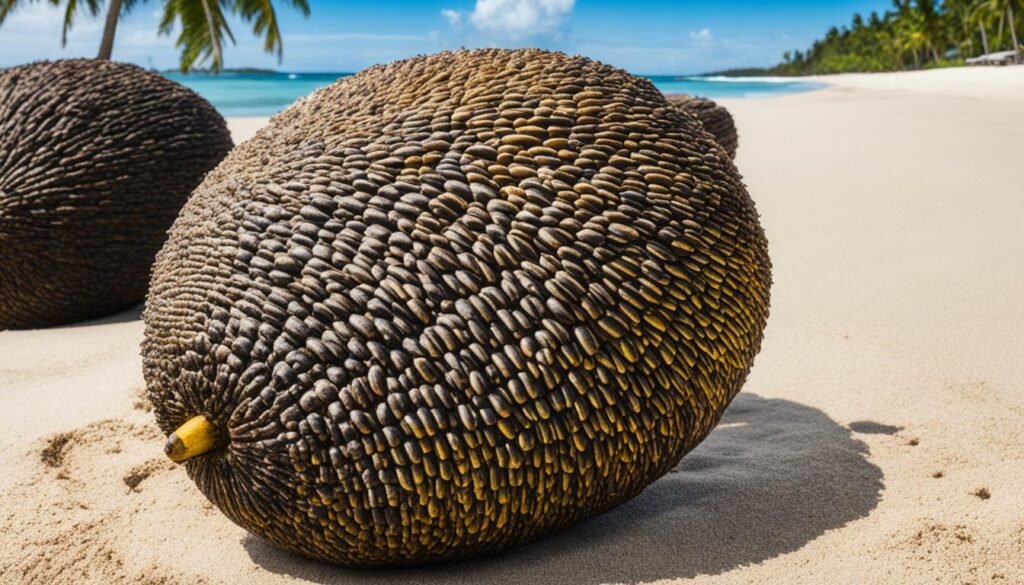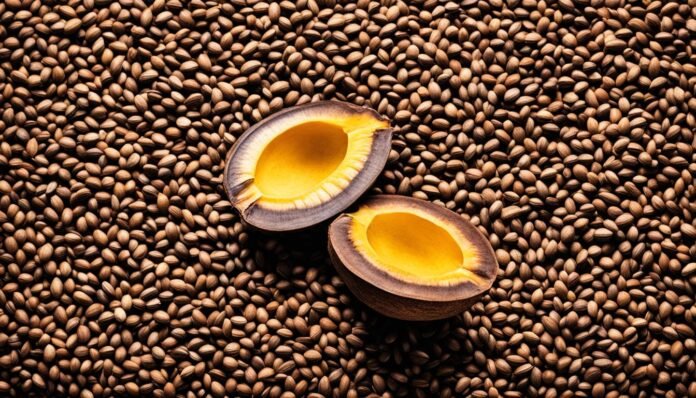The Seychelles islands are home to a botanical marvel – the coco de mer palm. It produces the world’s largest and heaviest seed, weighing up to 55 pounds. This unique palm, scientifically named Lodoicea maldivica, is also known as the double or sea coconut.
The coco de mer is a true botanical rarity. Its enormous seed and distinctive shape have fascinated people worldwide. This extraordinary plant continues to inspire awe and curiosity among nature enthusiasts.
Key Takeaways
- The coco de mer is the world’s heaviest seed, weighing up to 55 pounds.
- This palm species is endemic to the Seychelles islands in the Indian Ocean.
- The coco de mer is a true botanical rarity and plant curiosity.
- The seed’s large size and unique shape have captured the global fascination.
- Efforts are underway to ensure the survival of this extraordinary palm species.
Unveiling the Colossal Coco de Mer
The coco de mer is a stunning botanical wonder from the Seychelles Islands. It produces the world’s largest seeds, weighing up to 55 pounds. These massive coco de mer seeds captivate people’s imaginations worldwide.
A Botanical Marvel from the Seychelles
The coco de mer palm thrives in the Seychelles’ lush, tropical environment. Its unique, double-lobed seeds dwarf even mighty coconuts. These colossal seeds are prized for their beauty and potential healing properties.
Weighing in at a Staggering 55 Pounds
The size of the coco de mer seed is truly mind-boggling. It can weigh up to 55 pounds, as much as an 8-year-old child. This showcases the palm’s incredible power and adaptability.
“The coco de mer is a true botanical marvel, with its colossal seeds that defy belief. This unique palm species is a testament to the wonders of our natural world.”
The Enigmatic Double Coconut
The coco de mer is a fascinating palm species from the Seychelles Islands. It’s also called the double coconut or sea coconut. Its unique, dual-lobed shape inspired these interesting nicknames.
The scientific name for the coco de mer is Lodoicea maldivica. Its seed is the largest in the world, weighing up to 55 pounds. This feature has sparked widespread interest in the plant.
| Characteristic | Coco de Mer (Lodoicea maldivica) |
|---|---|
| Seed Weight | Up to 55 pounds |
| Seed Shape | Unique, dual-lobed |
| Native Habitat | Seychelles Islands |
| Conservation Status | Vulnerable |
The double coconut has inspired many legends and myths. Its unusual look has captured the imagination of explorers and botanists. Some link it to fertility, sensuality, and even the Garden of Eden’s “forbidden fruit”.
The Lodoicea maldivica palm continues to amaze those who see it. Its mysterious nature and rich history make it a true botanical marvel.
Exploring the Lodoicea Maldivica Palm
The Coco de Mer’s heart is the unique Lodoicea maldivica, a rare palm species. This botanical marvel grows only in the Seychelles. It’s the sole member of the Lodoicea genus, showcasing nature’s incredible diversity.
A Rare and Endemic Species
The Lodoicea maldivica, or Coco de Mer, is truly rare in the plant world. It’s native to Seychelles, growing in just a few remote spots.
This palm’s scarcity and unique traits make it exceptionally important botanically. Its limited habitat adds to its significance in the plant kingdom.
The Lodoicea maldivica palm amazes with its huge size and unique double-lobed fruit. As the only species in its genus, it’s a symbol of nature’s diversity.
This Seychelles native inspires wonder worldwide. It stands as a testament to the natural world’s remarkable resilience and fascination.
coco de mer 55 pounds: A Plant Curiosity
The coco de mer is a rare palm species with an extraordinary feature. Its massive seed can weigh up to 55 pounds. This colossal size fascinates botanists, horticulturists, and nature lovers alike.
The seed’s enormous size showcases nature’s wonders. It holds the title of the largest seed in the plant kingdom. Many find its unique characteristics intriguing and captivating.

The coco de mer seed is famous for its distinctive shape. It resembles a woman’s hips, adding to its mystique. This feature draws even more attention to this already remarkable plant.
This palm species grows naturally only in the Seychelles Islands. Its limited habitat makes it a true endemic plant. This rarity further increases its appeal to plant enthusiasts.
The coco de mer highlights the diversity of plant life on Earth. It stands out as a resilient species in a changing world. Its unique traits make it an exciting subject for study and appreciation.
Uncovering the Origins of the Sea Coconut
The sea coconut, or coco de mer, is a mysterious plant. Its discovery has sparked legends and myths. These stories have added to its worldwide appeal.
Legends and Myths Surrounding Its Discovery
One legend says sailors found huge fruits floating in the ocean. They thought mermaids or mythical creatures made these giant, double-lobed fruits. This idea both fascinated and scared them.
Another myth links the sea coconut to the Tree of Knowledge. It claims Adam and Eve threw the forbidden fruit into the sea. This story connects the plant to divine mysteries.
The true origins of the sea coconut remain unknown. Yet, this botanical marvel has fascinated people for centuries. It’s one of the world’s most intriguing plants.
“The sea coconut is a true botanical wonder, a testament to the incredible diversity and resilience of the natural world.”
The Global Fascination with This Botanical Rarity
The coco de mer, the world’s largest seed, has amazed people for centuries. Found only in the Seychelles, it sparks plant curiosity worldwide. This unique coconut embodies botanical rarity and inspires global fascination.
Nature lovers flock to the Seychelles to see this extraordinary palm tree. Witnessing the coco de mer in its habitat is a must for many. This botanical marvel drives research and conservation efforts.
The coco de mer’s appeal goes beyond its size and scarcity. Its split-nut design and floating seeds captivate imaginations globally. This plant curiosity has inspired many legends and myths.
“The coco de mer is a true botanical wonder, a testament to the extraordinary diversity and resilience of our natural world.”
Habitat loss and climate change threaten this botanical rarity. Protecting the coco de mer has become a worldwide priority. Conservationists aim to preserve this living link to Earth’s past.

| Characteristic | Description |
|---|---|
| Seed Weight | Up to 55 pounds (25 kg), the heaviest known seed in the world |
| Habitat | Endemic to the Seychelles islands, found in the Vallée de Mai Nature Reserve |
| Unique Features | Split-nut design, floating seeds, and distinctive palm fronds |
| Conservation Status | Endangered, due to habitat loss and limited natural regeneration |
Cultivation and Conservation Efforts
The coco de mer is the world’s largest seed. It’s a rare plant found only in the Seychelles. Protecting its habitats is vital for environmental groups and scientists.
The coco de mer needs careful cultivation and conservation. These efforts are crucial to ensure its survival. Without them, this botanical marvel could disappear forever.
Ensuring the Survival of the Largest Seed
Growing the coco de mer is tough. The palm takes 30 years to mature and produce its famous double-lobed seed. Scientists are working hard to develop better growing methods.
They aim to increase the population of this unique plant. Sustainable cultivation practices are key to achieving this goal.
- Seed collection and germination programs
- Establishment of dedicated conservation areas
- Public awareness campaigns to educate and engage the community
These conservation efforts are crucial for the coco de mer’s future. They help ensure this unique plant continues to inspire future generations.
“The coco de mer is a true botanical wonder, and its conservation is paramount to preserving the natural heritage of the Seychelles.”
Fascinating Facts About the Coco de Mer
Unveiling the Secrets of This Unique Palm
The coco de mer, a botanical marvel, grows only in the Seychelles. Its massive seed can weigh up to 55 pounds. This enigmatic palm has a unique reproductive cycle that intrigues nature lovers and scientists.
The coco de mer’s double-lobed fruit is called the “double coconut.” Its shape has inspired many legends about the palm’s origins. Botanists study how this unique feature evolved over time.
The palm’s rarity makes it globally appealing. It only grows in the Seychelles archipelago. Conservation efforts are crucial to protect this botanical treasure from various threats.
Understanding the coco de mer helps us appreciate nature’s wonders. By learning about it, we can support efforts to preserve it. Future generations deserve to experience this remarkable palm.

